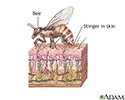Bug repellent safety
Insect repellent safety
Information
The safest bug repellent is to wear proper clothing.
- Wear a full-brimmed hat to protect your head and the back of your neck.
- Make sure your ankles and wrists are covered. Tuck pant cuffs into socks.
- Wear light-colored clothing. Light colors are less attractive than dark colors to biting insects. It also makes it easier to spot ticks or insects that have landed.
- Wear gloves, particularly while gardening.
- Check clothes regularly for bugs.
- Use protective netting around sleeping and eating areas to keep bugs at bay.
Even with proper clothing, when visiting an area with many insects, bug repellents such as those containing DEET or picaridin should be used.
- To avoid skin irritation, apply insect repellent to clothing. Test the repellent on a small, hidden area of clothing first to see if it will bleach or discolor the fabric.
- If areas of your skin are exposed, apply repellent there as well.
- Avoid using directly on sunburned skin.
- If using both sunscreen and repellent, apply sunscreen first and wait 30 minutes before applying repellent.
To avoid toxicity from insect repellents:
- Follow label instructions on how to use the repellent.
- DO NOT use in infants under 2 months of age.
- Apply repellent sparingly and only to exposed skin or clothing. Keep out of eyes.
- Avoid using high-concentration products on the skin, unless there is a high risk of disease.
- Use a lower concentration of DEET (under 30%) on pregnant women and small children.
- DO NOT breathe in or swallow repellents.
- DO NOT apply repellent to children's hands because they are likely to rub their eyes or put their hands in their mouth.
- Children age 2 months to 2 years old should not have insect repellent applied to their skin more than once in 24 hours.
- Wash repellent off the skin after the risk of being bitten by an insect is gone.
References
Fradin MS, Carroll SP. Protection from blood-feeding arthropods. In: Auerbach PS ed. Wilderness Medicine . 6th ed. Philadelphia, PA: Elsevier Mosby; 2012:chap 47.
United States Environmental Protection Agency. Insect repellents: reducing insect bites. Updated February 27, 2015. Available at: www2.epa.gov/insect-repellents. Accessed May 1, 2015.
-
Bee sting - illustration
Insect bites or stings can be painful and sometimes deadly. Most often bites or stings do not require medical care but an allergic reaction from the sting can be an emergency situation. If a sting occurs from a honey bee, remove the stinger. Do not use tweezers since pinching the stinger will cause more venom to be released. Use a cold compress to reduce swelling. Over the next 24 to 48 hours, observe the site for signs of infection (such as increasing redness, swelling, pain).
Bee sting
illustration
-
Bee sting - illustration
Insect bites or stings can be painful and sometimes deadly. Most often bites or stings do not require medical care but an allergic reaction from the sting can be an emergency situation. If a sting occurs from a honey bee, remove the stinger. Do not use tweezers since pinching the stinger will cause more venom to be released. Use a cold compress to reduce swelling. Over the next 24 to 48 hours, observe the site for signs of infection (such as increasing redness, swelling, pain).
Bee sting
illustration
Review Date: 4/21/2015
Reviewed By: Neil K. Kaneshiro, MD, MHA, Clinical Assistant Professor of Pediatrics, University of Washington School of Medicine, Seattle, WA. Also reviewed by David Zieve, MD, MHA, Isla Ogilvie, PhD, and the A.D.A.M. Editorial team.

